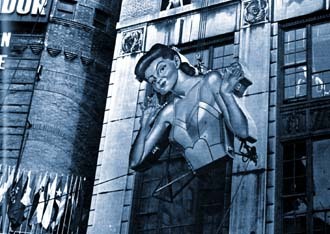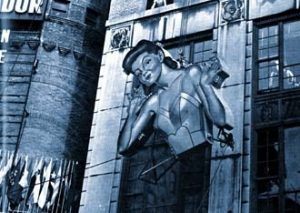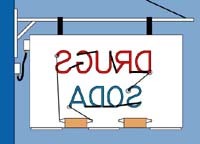Installers sometimes say they’d rather hang the neon signmaker than the neon sign. Installing projecting or wall-mounted neon signs up high isn’t easy. In fact, in 1952, Samuel Miller wrote, "Hanging a [neon] sign so that it’s mechanically secure is an art in itself."
Too often, neon signmakers are blamed for sign-construction faults, as well as for the improper tools and equipment that installers encounter.
This month, I’ll focus on how neon signmakers can facilitate installation, and what installers should consider when attaching neon onto a hook and hoisting it onto a rooftop.
Signs on site
Installers’ frustrations typically arise because the sign was designed for easy fabrication. However, no one thought about the sign’s setup or final operating position.
Let’s consider a typical projecting sign (Fig. 1). If this sign was installed onto the wall as sketched, a service person couldn’t access the back opening adjacent to the wall, without taking down the entire sign. The sign designer should have considered this and made the internal parts more accessible in the sign’s operating position, for example, from the bottom (Fig. 2).
In the workshop, you can turn the sign and access it from all angles, but once it’s affixed to a building, access becomes very limited. Thus, designers should render the sign on the building, but, before preparing the final sign blueprints, they should return to the engineering board and consider maintenance and repair work for the internal design.
In many cases, the labor to replace a 25-cent part may add up to thousands of dollars if an entire sign must be removed, repaired and reinstalled — all because no one considered working with the sign on site.
Ladder, bucket or crane?
Neon sign installers typically have a choice between a ladder truck, bucket truck or crane. From my experience, a ladder truck is a cheap choice for setting up and servicing electric signs. One disadvantage, however, is that a ladder truck forces you to use one hand to secure yourself, while using the other to work. Also, it’s not easy carrying tools or materials up a ladder.
A crane truck hoists large signs or sign parts into place, but it can’t be used to perform repair or service work (unless you install a "shark cage" onto the hook from which you’ll be working).
For neon and electrical work, a bucket truck is the most convenient conveyance, because you can carry spare parts, test instruments and hand tools in the bucket, and leave both hands free to work. Thus, I believe a bucket truck is sufficient and efficient for average shops.
For one- and two-person shops, renting trucks for a few hours to hook up a big sign is more economical than buying one.
If you consistently work on neon and electric signs, consider some aspects when choosing a particular model. For neon sign work, you need to move the bucket very close (closer than arm’s reach) to the sign face, whose surface is often already covered with glass tubing. Thus, the precision of all controls, even rotating the whole boom when fully extended, must be very smooth and precise — otherwise, you might do more damage than good.
Adjustable and strong support standoffs and feet are also essential. Big feet are preferred, or you might spend more time setting up the truck safely than working on the sign.
The bucket should include a storage container for tools and small parts. I insist upon an electrical power connection from the truck base to the bucket. This eliminates hassling with long, dangling extension cords that create a heavy pull on the boom, which requires a second person to guide the cord when you move the bucket.
Working in the bucket
When work requires a bucket truck, be sure to stand on a solid surface — solid enough to withstand the full load of the hydraulic standoffs with the boom lever fully extended.
Don’t underestimate the load you and the bucket’s weight will put on a single standoff — under the point load, the ground may start moving.
Place some rigid plates under the standoff feet to distribute the load over a larger surface. Make sure all standoffs are sharing the load properly before taking the first lift. Also, review your truck’s operation manual before attempting any unusually heavy work or work in awkward positions.
Block the area underneath your work zone. Often, work must be performed in pedestrian zones or above busy roads (Fig. 3). Clearly post that your site is a hard-hat work area. You can never be too sure that a tool or sign part won’t fall to the sidewalk. Even falling screws can become bullets.
Examine the sign before performing any service work. Most neon signs that require bucket-truck work are powered from a remote panel. Thus, before you start working, locate all service disconnects going to the sign, disconnect the branches and lock them in the open position, as required by the National Electric Code



 Tip Sheet4 days ago
Tip Sheet4 days ago
 Business Management2 weeks ago
Business Management2 weeks ago
 Women in Signs2 weeks ago
Women in Signs2 weeks ago
 Real Deal5 days ago
Real Deal5 days ago
 Benchmarks20 hours ago
Benchmarks20 hours ago
 Editor's Note1 week ago
Editor's Note1 week ago
 Line Time2 weeks ago
Line Time2 weeks ago
 Product Buying + Technology1 week ago
Product Buying + Technology1 week ago













